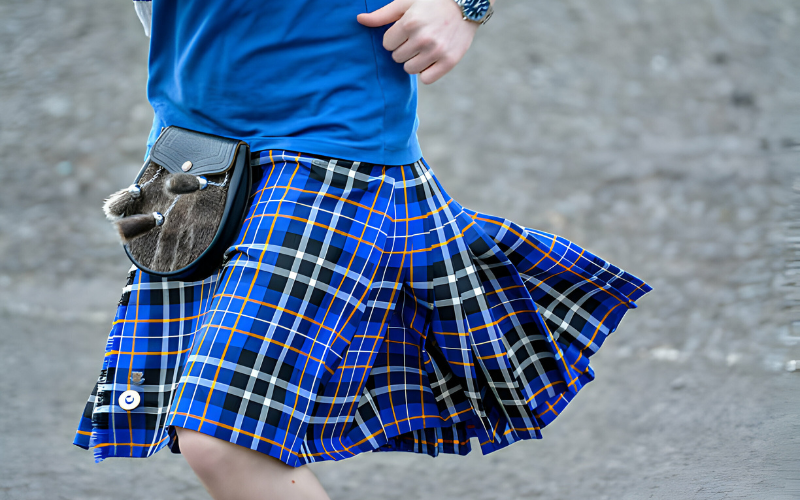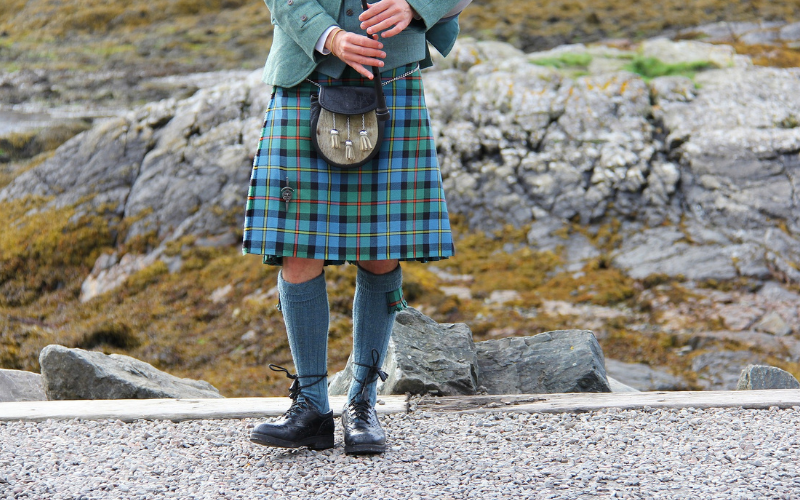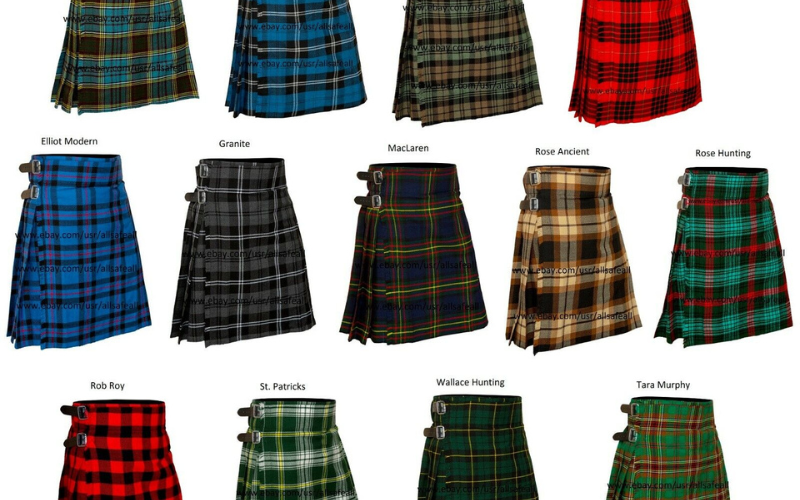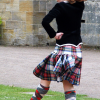Those plaid skirts for men are called kilts. They’re iconic attire for Scottish clans, right? Well, not so fast. The kilt actually has a long, tangled history that spans both Scotland and Ireland. Turns out, the kilt originated in Ireland, not Scotland. Surprised? You’re not alone. For centuries, the kilt has been strongly associated with Scottish culture and tradition. But the earliest kilts were made and worn in Ireland, eventually making their way to Scotland where they gained mainstream popularity. So while you can’t go wrong wearing a kilt to a Scottish festival, you should know the kilt’s true origins are Irish. Who knew? The kilt is one of those fashion items steeped in lore and tradition, but its actual history is far more complex than most people realize.
The History and Origins Of Kilts
The kilt as we know it today originated in the Scottish Highlands in the 16th century. However, the history of kilts goes back much further than that. The kilt evolved from the plaid, a long piece of tartan cloth that was worn over the shoulder and wrapped around the waist. The precursors to the kilt emerged in the late Middle Ages, with the plaid evolving into a belted plaid, then into the small kilt, and eventually into the tailored kilt.
The original kilt-like garment was the plaid, a long piece of tartan cloth that was gathered and belted at the waist. The belted plaid provided more protection from the weather but was still bulky to wear. In the 17th century, the plaid evolved into the small kilt or ‘philibeg’, where the plaid was pleated and sewn to create a separate woolen garment. The philibeg provided more freedom of movement and comfort.
In the 18th century, the small kilt developed into the tailored kilt we know today. The upper half could be draped over the shoulder during the day and the lower half buckled at the waist. New dyeing techniques also allowed for brighter, more distinct tartan patterns. The kilt became popular among the Scottish gentry and the military. After the Jacobite uprisings, the Dress Act of 1746 made traditional Highland dress illegal. However, the ban was lifted in 1782 and the kilt was adopted as the national dress of Scotland.
The modern kilt continues the tradition and spirit of the belted plaid, providing a unique symbol of Scottish heritage and pride. While kilts were originally common only in the Scottish Highlands, they have become popular throughout Scotland and the rest of the world. Kilts are no longer just for special occasions and can be seen being worn regularly on the streets of Scottish towns and cities. And despite their distinctly Scottish origin, kilts have found their place in popular culture and fashion worldwide.

Traditional Scottish Kilts vs. Irish Kilts
When you think of kilts, you probably picture the tartan plaid skirts traditionally worn by Scottish men. However, kilts are also an important part of Irish culture and history. While Scottish and Irish kilts share some similarities, there are a few key differences to be aware of.
Origins
The kilt originated in Scotland in the 16th century and was typically made of tartan wool cloth. The original Scottish kilts were more like cloaks that were belted at the waist. The kilt evolved into the pleated skirt we know today.
Irish kilts emerged around the same time but were less common until the early 20th century during the Irish cultural revival. They were usually made of solid-colored wool or linen and featured saffron embroidery. Unlike Scottish kilts, Irish kilts were inspired more by the native Irish leine or tunic than Scottish styles.
Design
Scottish kilts are made of tartan plaid cloth woven in intricate patterns representing different Scottish clans. They feature pleats in the back, with excess fabric belted around the waist.
Irish kilts are typically solid-colored or simple patterned and made of wool or linen. They have deep pleats all around and are also belted at the waist. Some Irish kilts feature embroidery or leather fringing for decoration. Unlike Scottish kilts, there are no specific clan tartans associated with Irish kilts.
Usage
In Scotland, kilts are mainly worn for special occasions connected to Scottish heritage or culture. They are popular attire for Highland games, weddings, and other formal events.
In Ireland, kilts are more commonly worn as casual or everyday attire, though some men still wear them for certain festivals or when participating in traditional Irish music and dance. Kilts experienced a surge in popularity in Ireland during the early 20th-century cultural revival movement as a way to celebrate Gaelic heritage.
While Scottish and Irish kilts share a common ancestor, each country has developed its own unique style and traditions surrounding these iconic skirts. Whether you’re celebrating your Scottish or Irish roots, the kilt is a symbol of honor, courage, and pride.

Key Differences Between Scottish and Irish Kilts
The kilt is most commonly associated with Scottish culture, but did you know the Irish also have their own version of the kilt? While Scottish and Irish kilts share some similarities, there are a few key differences to be aware of.
Tartan vs. Saffron
The Scottish kilt features a tartan pattern, made of crisscrossing horizontal and vertical bands in multiple colors. Tartan patterns are associated with Scottish clans and districts. Irish kilts, on the other hand, are typically made of plain saffron, a yellow-orange woolen fabric. Saffron dye was commonly produced in Ireland, which is how the saffron kilt got its name.
Pleating and Length
Scottish kilts are finely pleated, with knife-edge pleats that are stitched down to the waistband. The pleats face away from the wearer. Irish kilts have softer pleats that face towards the body. Scottish kilts are also longer, extending down past the knee, while Irish kilts are slightly shorter, resting just above or on the knee.
Sporran vs. Pouch
No kilt ensemble is complete without accessories. Scottish kilts are accompanied by a sporran, a leather pouch that hangs in front of the kilt. Irish kilts use a simple leather strap and pouch. The sporran is more decorative, coming in different styles like horse hair or fur, and is considered an important part of Scottish highland dress.
Usage and Events
Scottish kilts are most often worn for special occasions like weddings, Highland games, and parades. They are a source of national pride for Scottish people. Irish kilts are less ceremonial and more commonly worn as an everyday garment, especially in the early 20th century in rural areas. Today, Irish kilts are still worn by some for national holidays and cultural events.
While the kilt is an iconic part of Scottish dress and tradition, the Irish kilt also has a long, rich history and plays an important role in expressing Irish identity and heritage. Both are unique cultural garments that continue to make a statement today.
Modern Kilt Fashions in Scotland and Ireland
Modern kilt fashions are not just popular in Scotland, but also gaining ground in Ireland. While kilts are most traditionally associated with Scottish culture, the kilt’s roots actually trace back to Irish history. Today, both Scottish and Irish kilt makers are putting their own modern spins on the traditional kilt.
In Scotland, kilt makers have been experimenting with new patterns and fabrics to create fashionable streetwear kilts for everyday wear. Contemporary kilts come in a variety of tartan patterns beyond the traditional clan tartans, using modern colored fabrics like grays, blacks and reds. Some kilt makers have also created “urban kilts” in solid black, cargo kilts with pockets, and hybrid kilts that blend a kilt front with pants.
Ireland’s kilt heritage dates back to the 16th century when the belted plaid or ‘great kilt’ was popular. While kilts faded from everyday wear, they’ve seen a resurgence in Ireland as a symbol of Celtic pride. Contemporary Irish kilts are available in a variety of solid colors and Irish tartan patterns. Some Irish kilt makers have put an urban spin on kilts with features like straps, buckles, and asymmetrical pleating.
Whether you’re looking to show your Celtic pride or make a fashion statement, the modern kilt offers a versatile and unique alternative to pants. Both Scotland and Ireland have a long kilt-making tradition, and today’s kilt fashions celebrate the kilt’s heritage while giving it a stylish, contemporary twist. So next time you’re deciding between pants or a kilt, why not go for the kilt?
Are Kilts For Everyone? How To Wear Kilts Respectfully
Kilts are most closely associated with Scottish culture, but their history is a bit more complex. While kilts are an important part of Scottish dress and heritage, they have also become popular in Irish culture and among reenactment groups. If you want to wear a kilt to honor your heritage or just because you find them comfortable and stylish, there are a few things you should keep in mind.
Do Your Research
Before donning a kilt, do some research into the different kinds of kilts and what they represent. Know the difference between a Scottish kilt and an Irish kilt. Understand the significance of the tartan patterns and how they relate to Scottish clans. Educate yourself on the proper way to wear a kilt – where the pleats go, how to fasten it, what accessories traditionally accompany it.
Choose an Appropriate Tartan
If wearing a kilt to represent your Scottish heritage, choose a tartan pattern that matches your clan or family name. There are many tartan patterns to choose from, so make sure you select one that is correct and approved. As for Irish kilts, solid colors like green, blue or black are more common and neutral. For a utilikilt or casual kilt, you have more flexibility in colors and patterns.
Dress Respectfully
Whether attending a Highland games, festival, or just wearing your kilt casually, dress appropriately. Pair your kilt with a button-down shirt, vest, jacket, knee-high socks, and Ghillie brogues or other leather shoes. Top it off with accessories like a Sgian Dubh knife, sporran (pouch), kilt pin, belt, and hat. Make sure your kilt falls just above your knees and the pleats are neatly arranged. Practice good posture and manners when wearing traditional dress.
Kilts are a versatile and comfortable garment that anyone can wear and appreciate. However, they also have deep cultural significance, especially for those of Scottish and Irish descent. Do your part to honor and respect that heritage by learning about the history of kilts and wearing them properly with pride. When in doubt, ask others who frequently wear kilts for their input and guidance. With an open and willing attitude, you’ll master the art of wearing a kilt respectfully in no time.
Conclusion
So there you have it, the surprising truth behind the origins of the kilt. While today kilts are an iconic symbol of Scottish heritage, they actually have Irish roots.
The kilt originated in Ireland and made its way to Scotland, where it was eventually adopted as a national dress.
Though the kilt is more popularly associated with Scottish clans and tartans now, its early history is undeniably Irish. The next time you see a kilt, you’ll know there’s more to




Leave a reply